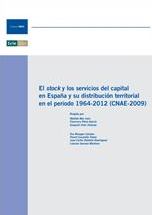The update of the BBVA Foundation-Ivie capital stock database confirms that investment in Spain is not recovering
Spain’s recovery should be based on a new accumulation pattern of more productive assets and on the efficient use of the available endowments
This is what the data tells us: investment, and with it capital stock, which is the result of investments accumulated over time, is one of the magnitudes hit hardest by the economic crisis. Since the crisis started in 2007, the cumulative fall in investment has reached nearly 50 per cent. Furthermore, Spanish economy has gone from investment-to-GDP levels that exceeded 30 per cent to 18 per cent in 2013.
 What happens if investment, which in the past has been a very important component of aggregate demand, is kept at a low level? In the short term, investment cannot contribute enough to the recovery in demand, so it is necessary to stimulate it by turning to other sources such as the new international markets that do grow in times of crisis. From a long-term perspective, low levels of investment can affect future growth since they slow the increase in capital stock and the contribution of this factor to growth, a component which has been the basis of the growth of Spain’s economy in the last fifty years and which helped employment and per capita income to grow.
What happens if investment, which in the past has been a very important component of aggregate demand, is kept at a low level? In the short term, investment cannot contribute enough to the recovery in demand, so it is necessary to stimulate it by turning to other sources such as the new international markets that do grow in times of crisis. From a long-term perspective, low levels of investment can affect future growth since they slow the increase in capital stock and the contribution of this factor to growth, a component which has been the basis of the growth of Spain’s economy in the last fifty years and which helped employment and per capita income to grow.
This is one of the key messages flowing from the report El stock y los servicios del capital en España y su distribución territorial en el periodo 1964-2012 (CNAE-2009) which offers the main results of the latest BBVA Foundation-Ivie capital stock database.
As said in the report, other sources of growth must now take over. Instead of relying on a large number of endowments, to achieve recovery Spain must follow a new pattern of accumulation based on more productive assets, such as ICT, and on a real and more efficient use of the already available endowments, their under-utilisation being one of the major imbalances of Spain’s current economy.
If Spain does not grow, it is not due to its lack of physical capital, but because, as asserted in the report, having lost the pull of its traditional engines, Spain has not been able to replace them with new entrepreneurial projects to set in motion the country’s production capacity, which has been underused since the onset of the crisis.
Database update
The capital stock estimates for Spain, its autonomous communities and provinces, which have been developed by the BBVA Foundation and the Ivie for over fifteen years, cover the 1964-2012 period and provide information disaggregated by 18 assets and 31 industries for the national territory, by 25 industries for its regions and by 15 industries in the case of the provinces.
This data allows to analyze the sources of economic growth and to assess relevant public policies, such as those related to infrastructures or to ICT (information and communication technologies). Also, the offered territorial information is useful to know the location of investment in the different assets and the differences in the structure of capital endowments of the autonomous communities and provinces; as well as to analyze the trends of accumulation of each asset and study the growth of capital services and the location of the activities, in the different regions and provinces.
Further information:
Database El stock y los servicios del capital en España y su distribución territorial
Report El stock y los servicios del capital en España y su distribución territorial en el periodo 1964-2012 (CNAE-2009). (In Spanish)
Press release. (In Spanish)






